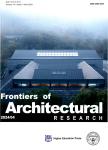A typological,environmental and socio-cultural study of semi-open spaces in the Eastern Mediterranean vernacular architecture:The case of Cyprus
作者机构:Department of ArchitectureUniversity of Cyprus1678 NicosiaCyprus
出 版 物:《Frontiers of Architectural Research》 (建筑学研究前沿(英文版))
年 卷 期:2021年第10卷第3期
页 面:483-501页
核心收录:
学科分类:0303[法学-社会学] 1305[艺术学-设计学(可授艺术学、工学学位)] 0601[历史学-考古学] 0202[经济学-应用经济学] 081302[工学-建筑设计及其理论] 08[工学] 0813[工学-建筑学] 0814[工学-土木工程] 0833[工学-城乡规划学]
基 金:This research is based on the findings of two research programmes with the acronyms BioCultural and BioVernacular funded by the University of Cyprus 2013-15 and by the Republic of Cyprus and the European Regional Development Fund 2012-14 respectively
主 题:Semi-open spaces Vernacular residential architecture Different climatic regions and topographies Typology Environmentally responsive design Socio-cultural aspects
摘 要:Semi-open spaces-largely incorporated in vernacular dwellings in Cyprus during the 19th and 20th centuries-formed diachronically significant socio-cultural, functional and environmental features of the vernacular architecture of the area. The climate of the Eastern Mediterranean region, i.e., hot summers and mild winters, encouraged the use of open weather protected spaces, thus leading to the widespread incorporation of such spaces in the vernacular architecture of the region. This paper focuses on the interconnections between architectural forms and human comfort, convenience or pleasure in relation to the semiopen spaces found in the vernacular architecture of Cyprus-an island in the Eastern Mediterranean region. For the purpose of this research, characteristic traditional settlements found in the coastal, lowland and mountainous areas-which represent three different climatic regions and topographies of the island-were selected for an in-depth investigation. The findings confirm a high frequency of semi-open spaces, as well as the existence of a remarkable richness of typologies. Although semi-open spaces constitute a fundamental part of the structure of these vernacular dwellings in all climatic regions examined, they dominate in the lowland regions due to the particularly hot climate, as well as the specific activities of the inhabitants of these areas. The prevailing architectural forms and constructions of these spaces in each climatic region under investigation was found to be closely adapted to the local resources, terrain and climate, while also being related to the social, household and agricultural needs of the inhabitants, thus underlining their sustainable and locus-specific conception. Research findings can contribute towards critically re-thinking semi-open spaces and their inherent value in rehabilitation projects, as well as in contemporary residential architecture.



